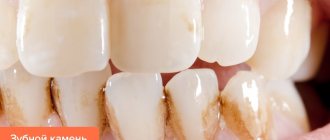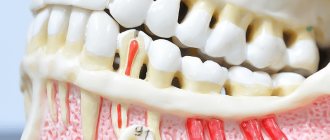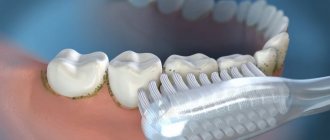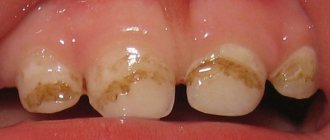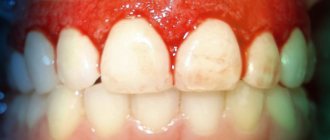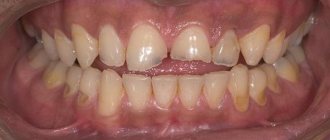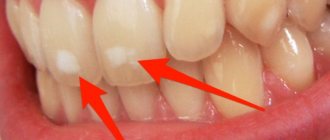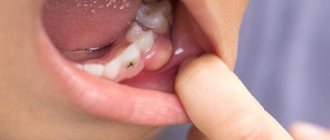A tooth has broken off and is cutting my tongue. Can I sharpen it with a nail file at home?
When there is a lot of stupidity, you can do anything.
They used a file to file their nails; it was unlikely that it was processed after each use. There are all sorts of microbushes there. And we are thinking of putting this nail file into our mouths. But even if the file is clean, is it worth putting it in your mouth? No dentist will recommend filing chipped teeth at home with nail files. Even if its edges cut your tongue or cheek. The doctor will say that this is unhygienic, dangerous, pointless. And that by filing your teeth, you can turn things around in such a way that there will be even more pain. Damage the enamel, grind down the wrong surface, after which it will be impossible to eat or sleep at all.
But anyone who has had their teeth chipped knows how unpleasant it can be. The tongue or cheeks can be cut so that a real wound is formed. And no painkillers will help. The tooth itself may not hurt, but the mucous membranes around it may be seriously injured.
I agree with people who will say that in the most urgent cases you can try. When there is no one to go to and it is no longer possible to endure. But don't do it as decisively as you want. Process the tool.
If it is difficult to stop a person, the pain is so strong and the determination to file the disturbing tooth on your own drowns out the voice of reason, even use your filing tool.
Wash the file thoroughly with alcohol or at least hot water and soap. Rinse multiple times, not just once. And only after this procedure, start cutting off the sharp pin. If you feel that the file is touching a nerve, you will have to complete this manipulation and go “confessingly” to a good dentist.
If a tooth breaks off. The best recommendation is to see a dentist. The fact is that you are unlikely to be able to determine on your own the severity of the damage. Possible infection can lead to unpleasant consequences and the result will be that “the miser pays twice.”
Treating a tooth yourself is not a good idea. Especially sharpen it with a nail file. Now it is unknown what the nail files are made of. And if you examine a nail file under a microscope, you can see a lot of harmful things. And the file is intended primarily for hands and feet.
So sharpening a tooth with a file is not a good idea. You can introduce some kind of infection into your mouth and it will only get worse. Either the lips will swell, or the herpes will pop out. So the best decision if a tooth chips is to wait until the morning and go to the dentist. He will do everything quickly and reliably
Although, if your tongue really cuts the tooth, take a file and carefully sharpen it. The main thing is not to let the nail file touch your tongue and lips. If, however, you have the patience to endure and still go to the dentist, I wish you good doctors as in the photo below. The main thing is positive, and then pain)
Theoretically, it is very possible to sharpen a chipped tooth. That is, you can round the sharp edge, make it less cutting, and save yourself from the suffering that can be caused by constant mechanical friction of the fragment against the tongue.
It is absolutely clear that this method is not professional, not sterile, not a panacea, and generally not acceptable. But if we don’t academicize the situation and assume that if we don’t take independent emergency measures (being, for example, in a dense forest with a nail file in our hands and without a dentist in our pocket), we can lose a healthy tongue in a few days or a normal psyche from pain, then Of the two emerging evils, you need to choose the lesser. And then, armed with a file treated with alcohol, intuition and a mirror, you can make several movements on the tooth. May I help. And they don’t do such manipulations when there is no other way out.
No, you shouldn’t do this, when my tooth chipped, I went to the dentist, fearing that he might put a filling or something, but he just palpated it for me, now it doesn’t cut and it doesn’t hurt to drink cold/hot water, you shouldn’t do it with a file it can be dangerous, you may get to the nerve, make it worse, go to the dentist (my advice to you).
Can. There is absolutely nothing wrong with this. Otherwise you will continue to suffer. File off the sharpest edge (just use a file several times, it’s easy), the dentist will do the rest when you get to him.
Theoretically, it is possible - the tooth is not an appendix, although people even cut it out for themselves, being far from civilization - at the North Pole - there are no surgeons there, there are no clinics. There was no way out - the man cut it out for himself. And everything went well.
But with a tooth - it seems possible, but suddenly an open nerve forms there - the tip is not cut off, but another piece of the tooth breaks off. Or an already open nerve, then you can run into terrible pain!
On the other hand, the file must be impeccably sterile so that, God forbid, it does not cause an infection!
You can very carefully try to see what it feels like, is there any pain, sharpen the tooth and everything will be fine! But the main thing is not to get infected!
I can tell you from my stupidest experience: once a tooth fell off, I didn’t go to the dentist, the tooth crumbled and began to hurt terribly. I was sick because of the root. And there was such a desire to take something thin and sharp, climb into the cavity and at least clean everything there a little. I know - this is very stupid, especially - not the Far North - there is an avalanche around dentists - you pay money - they will politely and carefully solve the problem with your tooth! There are pharmacies nearby - if the pain is severe, there are plenty of painkillers.
Who is indicated and contraindicated
Teeth grinding is a dental procedure that is aimed at correcting visible defects: uneven edges, enamel damage, and malocclusion. In addition, it is used during operations, using it as a preparatory stage.
Photos before and after teeth filing:
Before going for dental filing, consultation with a specialist is required. Whether it is possible to file the front teeth depends on the presence of contraindications, which include:
- bruxism (teeth grinding during sleep, occurs regularly at night);
- increased sensitivity of enamel;
- accelerated destruction of tooth enamel;
- the patient's exposure to bad habits (gnawing nuts with his mouth, nibbling the ends of pens and pencils);
- increased risk of injury to incisors or canines (especially in boxers and wrestlers).
If the specialist did everything correctly, the teeth will be filed without difficulty. There can be only one nuance - the enhanced sensuality of the enamel. But it lasts for a few days and then goes away. The existing correction options are calculated by the doctor you contacted. Dental grinding is necessary when other correction options, in the opinion of a specialist, will not help.
At home
Fear of doctors and thoughts about the pain of professional manipulations often lead to patients trying to cope with the existing problem on their own. Teeth filing is also no exception.
Dentists share their experience that people often come to appointments whose enamel has been severely damaged by attempts to cut off part of it with various improvised tools in the desire to improve the aesthetic appearance of the jaw row with prominent front teeth or the presence of chips.
In addition to the problem of high sensitivity, these patients experience cracks in the hard tissue, as well as dentin damage, which develops as a result of bacteria entering the dentinal tubules through open pores.
The consequence of such independent actions can be the development of caries, pulpitis and numerous complications that can lead to partial or complete tooth destruction.
Dentists categorically prohibit performing teeth filing procedures at home. Only a specialist can determine the need for an operation to remove a section of enamel and carry it out efficiently, without the risk of complications.
The cost of filing teeth depends on the reasons for which it is carried out and what result is needed to achieve:
- preparation for caries - from 200 to 350 rubles per row element;
- treatment of enamel after removing braces – 550-650 rubles;
- identification of traumatic occlusion and grinding of one tooth – 200-300 rubles;
- cutting down a tooth for a crown – 130-200 rubles;
- filing a molar under an orthodontic structure – 150-200 rubles.
Find out how teeth are prepared in the video.
Teeth filing is a rather painstaking procedure that requires high skill and care from the dentist.
If it is necessary to perform it for cosmetic purposes, it is worth consulting with your doctor about the possibility of another method of therapy.
At the same time, when installing an orthodontic structure or prosthesis, it will not be possible to do without preparing the teeth. If you have ever experienced teeth filing, please share your feelings during and after the procedure in the comments section.
If you find an error, please select a piece of text and press Ctrl+Enter.
Technique
The operation of cutting down teeth to straighten them takes place in several steps:
- Preliminary preparation: the dentist assesses the dental condition. Then determines whether there is a need to file hard tissue. At the end, a conclusion is made about whether the patient has contraindications to the operation.
- Finding areas that have problem areas. To do this, a carbon copy, liquid spray or wax strip is taken, and the dentist identifies irregularities and abnormal heights of some teeth. Those areas that need filing are stained more heavily.
- Anesthesia and filing. The process is carried out differently in each case. Each patient has an individual dental arrangement. This is also due to the fact that there are various goals that need to be achieved. Also important is the individual shape of the teeth, which need to be ground down to straighten them.
For example, processing chewing molars. The dentist carefully files down the top layer of enamel from the surface of the tubercles. To file the central incisors, the doctor uses cutting movements in various directions.
There are cases when it is necessary to make a preventive model for diagnosis, which is based on casts of the jaws. The samples received by the dentist are thoroughly reviewed and filing options are assessed. The standard tools in the operation are carborundum cutters or diamond burs.
Possible complications
If we talk about complications of tooth sharpening, then, first of all, it is a reaction expressed in increased sensitivity of the enamel after surgery. This usually goes away within a week. If the sensitivity does not go away, you should contact the dentist who did the filing. As a rule, no more complications arise if the operation was performed by a qualified specialist and not by an amateur.
Increased sensitivity is the effect of dentin, which is located under the enamel. It passes through many channels. They contain nerve endings. When the thickness of the enamel layer decreases, the pressure changes, resulting in pain from hot or cold drinks and foods. During adaptation, dentists advise not to eat solid foods, very cold or hot foods, or highly acidic drinks.
What complications can there be?
If the filing procedure was carried out by an experienced specialist without errors, then there should be no significant complications. The only problem that the patient may encounter is increased tooth sensitivity. This is especially evident when consuming very cold or hot foods and drinks.
There is a simple explanation for this side effect: under the enamel there is dentin, which has many tubules with nerve endings inside. As the thickness of the enamel decreases, the pressure changes, causing some foods to cause discomfort.
To reduce tooth sensitivity, experts recommend abstaining from eating too hard foods, hot and cold dishes, and sour drinks for a while. In addition, for oral hygiene it is necessary to use a toothbrush with soft bristles, use therapeutic and prophylactic toothpaste, and special rinses designed for sensitive teeth.
Home filing
Some people wonder if it is possible to sharpen their front teeth at home and how to do it.
If there is fear of doctors and the operation itself, and there are thoughts about the unprofessionalism of specialists, patients try to file their teeth themselves.
Experts, without any reservations, forbid even trying to do the filing yourself. The patient will not be able to determine the condition of the oral cavity and the necessary actions to be taken. Only a professional dentist can perform a high-quality operation. This is a guarantee of quality and absence of complications.
If you need to file your teeth, the price will depend on what exactly needs to be done.
Is it possible to straighten your teeth yourself?
It is unlikely that any doctor will answer this question, since today medicine does not know a folk remedy that does something to teeth.
Most likely, if there was such a thing, everyone would have been sitting at home for a long time and straightening their teeth. But, alas. Once upon a time, back in the Middle Ages, there were some methods. Most likely they were barbaric. Well, history doesn’t know about a positive outcome either. The only known story is that once upon a time rich aristocrats, chasing perfection, got into trouble. They were sent to overseas specialists, it is not clear what their focus was. And they suggested that they carry a saucer of water on their heads and loosen their teeth with thread. At the very least, this is a scam, at most, it is a fraud, because they paid a lot of money for this method.
The most barbaric method was softening the dental sinuses with a miracle elixir, as charlatans claimed. In fact, it was an ordinary chemical mixture.
Modernity has stepped forward and found a way out. You can straighten your teeth at home using special available tools . And remember, these are doubtless magical elixirs and not even healing folk herbs, but normal, harmless devices for correcting malocclusion without expensive orthodontic services. To do this, you don’t need to show off for two years with “iron” in your teeth.
Today there is an alternative to heavy braces that is lighter, less noticeable and not financially intimidating.
Important! You cannot straighten your teeth at home using improvised means without consulting a specialist . This can only make things worse.
If you value your health and beauty and you cannot ignore the problems that arise, then be sure to consult a doctor. Self-intervention is often fraught with major problems. As a result, instead of 1.5–2 years of bite correction, you can get 4–5 years of painful treatment.
And this is not intimidation. This is a very proven fact in medical practice. Similar cases have happened more than once. As they say: “The miser pays twice.” It is clear to the naked eye that this is the point in our case that opens the eyes of greedy people who are risking their health. It is up to everyone to decide what is better or even what is more profitable.
Who is indicated and contraindicated
Teeth grinding is a dental procedure that is aimed at correcting visible defects: uneven edges, enamel damage, and malocclusion. In addition, it is used during operations, using it as a preparatory stage.
Photos before and after teeth filing:
Before going for dental filing, consultation with a specialist is required. Whether it is possible to file the front teeth depends on the presence of contraindications, which include:
- bruxism (teeth grinding during sleep, occurs regularly at night);
- increased sensitivity of enamel;
- accelerated destruction of tooth enamel;
- the patient's exposure to bad habits (gnawing nuts with his mouth, nibbling the ends of pens and pencils);
- increased risk of injury to incisors or canines (especially in boxers and wrestlers).
Indications and contraindications
Doctors have been using this technology of filing individual units, that is, tooth preparation, as it is called in medicine, since the 19th century. But if earlier it was used as a treatment for caries, today it is used only for orthodontic correction of malocclusion, prosthetics or restoration of anterior teeth.
Only the doctor can decide in which cases filing will be a good choice. Although not all experts agree on the usefulness and desirability of its implementation, there are situations when it remains the only way to eliminate the defect:
- Fixation of the crown – to level the surface so that the prosthesis fits perfectly to the tooth. In this case, it is given the correct geometric shape and all sides are sharpened so that the hard fabrics and artificial material are in close contact, and the product does not stand out from the general range.
- Installation of veneers - in order for the plate to be firmly fixed and also look natural when smiling, you need to remove part of the enamel to fit its dimensions. In this case, only the front (vestibular) surface of the tooth is treated.
- Preparation for special inlays - in order to mask the formed voluminous cavities as a result of carious lesions, ceramic or metal products are installed. To ensure a tight fit to the remaining part of the tooth, the inner walls of the hard tissues should be carefully prepared.
- Orthodontic treatment of malocclusion is done in different cases. Sometimes it is necessary to file down part of the incisors to make room for the correct placement of all units without completely removing them. In other situations, molars are filed for convenient fixation of braces. This is especially true when the row is highly crowded.
- Minor injuries to the enamel - if chips have formed, then to correct the aesthetic appearance of the teeth, as well as to ensure the comfort and safety of the oral cavity, you need to carefully file down the injured part.
- Incisors are too long by nature - sometimes they protrude significantly and stand out from the crowd, spoiling a person’s appearance. Also, such a defect can negatively affect diction and the quality of food processing. By filing them, you can achieve evenness of the dentition and normalization of the bite.
- The presence of sharp edge surfaces - when the anatomical shape of individual units is far from ideal and injures neighboring tissues.
In pediatric dentistry, we encounter such a phenomenon as elongated fangs. This anomaly can be either congenital or appear from external influences, for example:
- in the presence of adenoids;
- from rickets;
- after sucking a pacifier for a long time;
- as a result of various inflammatory processes in the oral cavity;
- from the habit of biting lips or cheeks, etc.
Doctors try to rarely resort to such a procedure, since it is irreversible and not always useful. When making a decision, important contraindications should be taken into account:
- accelerated erasability;
- bruxism;
- increased sensitivity of enamel;
- bad habits such as opening bottles with teeth or excessive love for nuts and other hard foods;
- when the patient’s lifestyle involves a high risk of injury – boxing, wrestling, etc.
Technique
The operation of cutting down teeth to straighten them takes place in several steps:
- Preliminary preparation: the dentist assesses the dental condition. Then determines whether there is a need to file hard tissue. At the end, a conclusion is made about whether the patient has contraindications to the operation.
- Finding areas that have problem areas. To do this, a carbon copy, liquid spray or wax strip is taken, and the dentist identifies irregularities and abnormal heights of some teeth. Those areas that need filing are stained more heavily.
- Anesthesia and filing. The process is carried out differently in each case. Each patient has an individual dental arrangement. This is also due to the fact that there are various goals that need to be achieved. Also important is the individual shape of the teeth, which need to be ground down to straighten them.
For example, processing chewing molars. The dentist carefully files down the top layer of enamel from the surface of the tubercles. To file the central incisors, the doctor uses cutting movements in various directions.
There are cases when it is necessary to make a preventive model for diagnosis, which is based on casts of the jaws. The samples received by the dentist are thoroughly reviewed and filing options are assessed. The standard tools in the operation are carborundum cutters or diamond burs.
Possible complications
If we talk about complications of tooth sharpening, then, first of all, it is a reaction expressed in increased sensitivity of the enamel after surgery. This usually goes away within a week. If the sensitivity does not go away, you should contact the dentist who did the filing. As a rule, no more complications arise if the operation was performed by a qualified specialist and not by an amateur.
Increased sensitivity is the effect of dentin, which is located under the enamel. It passes through many channels. They contain nerve endings. When the thickness of the enamel layer decreases, the pressure changes, resulting in pain from hot or cold drinks and foods. During adaptation, dentists advise not to eat solid foods, very cold or hot foods, or highly acidic drinks.
Reviews
They filed down my tooth for a crown. Even with pain relief, I felt discomfort. This is a rather unpleasant procedure. But the main thing is that after this the product is installed efficiently, otherwise the exposed tooth will quickly collapse.
When I decided to get veneers, I understood that I would have to cut off part of the surface. But I don’t regret it at all, because my smile has become perfect. The most important thing in this is choosing a good specialist so that he does not damage your enamel.
After this treatment, I suffered from tooth sensitivity for a long time. I used pastes, rinses, etc. The doctor said that this was a normal reaction, since the nerve endings were left without protection. I hope that after the crown is installed, these sensations will go away.
Home filing
Some people wonder if it is possible to sharpen their front teeth at home and how to do it.
If there is fear of doctors and the operation itself, and there are thoughts about the unprofessionalism of specialists, patients try to file their teeth themselves.
Experts, without any reservations, forbid even trying to do the filing yourself. The patient will not be able to determine the condition of the oral cavity and the necessary actions to be taken. Only a professional dentist can perform a high-quality operation. This is a guarantee of quality and absence of complications.
If you need to file your teeth, the price will depend on what exactly needs to be done.
Is it possible to do sawing at home?
Many people, due to some beliefs or circumstances, are afraid of doctors. Therefore, the thought of painful dental procedures is terrifying. Therefore, some decide to deal with the problem on their own. Teeth filing in this case is no exception.
Often, after filing teeth on their own at home, people become patients of the dentist.
Dentists note that they are often approached by patients whose tooth enamel has been severely damaged as a result of attempts to file problem areas on their own. Moreover, they did this with a variety of improvised means. As a result of such manipulations, a person’s enamel is severely damaged.
The result of self-filing of teeth is often caries, pulpitis, and various other dental diseases, which ultimately lead to tooth loss. Experts categorically prohibit carrying out any manipulations of this kind at home. Only an experienced specialist can determine the feasibility of carrying out the procedure on an individual basis and do it efficiently without the risk of complications.
The cost of such a dental operation depends on the complexity, the reason for which it should be carried out, and what result needs to be achieved. On average, in clinics it varies within:
- Preparation of carious cavities – 200-350 rubles per tooth
- Treatment of tooth enamel before or after removing braces - from 550 to 650 rubles per unit
- Grinding of chips as a result of tooth injury – 200-300 rubles
- Sawing down the dentition for installation of crowns – 150-200 rubles
- Preparation of molars for installation of orthodontic structures – 150-200 rubles
In addition, you will have to pay for diagnostics. Each dental clinic has individual prices for examinations.
Teeth filing is a painstaking procedure that requires attentiveness and high professionalism of the dentist. If it needs to be done for cosmetic purposes, it is necessary to consult with doctors about alternative methods of correcting a smile, since filing is, after all, irreparable damage to the integrity of the tooth. At the same time, when installing braces, veneers, ceramic or metal-ceramic structures, you cannot do without such a procedure. In any case, during the consultation, the doctor will explain in detail all the possible risks and consequences of filing teeth.
Who is indicated and contraindicated
Teeth grinding is a dental procedure that is aimed at correcting visible defects: uneven edges, enamel damage, and malocclusion. In addition, it is used during operations, using it as a preparatory stage.
Photos before and after teeth filing:
Before going for dental filing, consultation with a specialist is required. Whether it is possible to file the front teeth depends on the presence of contraindications, which include:
- bruxism (teeth grinding during sleep, occurs regularly at night);
- increased sensitivity of enamel;
- accelerated destruction of tooth enamel;
- the patient's exposure to bad habits (gnawing nuts with his mouth, nibbling the ends of pens and pencils);
- increased risk of injury to incisors or canines (especially in boxers and wrestlers).
If the specialist did everything correctly, the teeth will be filed without difficulty. There can be only one nuance - the enhanced sensuality of the enamel. But it lasts for a few days and then goes away. The existing correction options are calculated by the doctor you contacted. Dental grinding is necessary when other correction options, in the opinion of a specialist, will not help.
Technique
The operation of cutting down teeth to straighten them takes place in several steps:
- Preliminary preparation: the dentist assesses the dental condition. Then determines whether there is a need to file hard tissue. At the end, a conclusion is made about whether the patient has contraindications to the operation.
- Finding areas that have problem areas. To do this, a carbon copy, liquid spray or wax strip is taken, and the dentist identifies irregularities and abnormal heights of some teeth. Those areas that need filing are stained more heavily.
- Anesthesia and filing. The process is carried out differently in each case. Each patient has an individual dental arrangement. This is also due to the fact that there are various goals that need to be achieved. Also important is the individual shape of the teeth, which need to be ground down to straighten them.
Possible complications
If we talk about complications of tooth sharpening, then, first of all, it is a reaction expressed in increased sensitivity of the enamel after surgery. This usually goes away within a week. If the sensitivity does not go away, you should contact the dentist who did the filing. As a rule, no more complications arise if the operation was performed by a qualified specialist and not by an amateur.
Increased sensitivity is the effect of dentin, which is located under the enamel. It passes through many channels. They contain nerve endings. When the thickness of the enamel layer decreases, the pressure changes, resulting in pain from hot or cold drinks and foods. During adaptation, dentists advise not to eat solid foods, very cold or hot foods, or highly acidic drinks.
Home filing
Some people wonder if it is possible to sharpen their front teeth at home and how to do it.
If there is fear of doctors and the operation itself, and there are thoughts about the unprofessionalism of specialists, patients try to file their teeth themselves.
Experts, without any reservations, forbid even trying to do the filing yourself. The patient will not be able to determine the condition of the oral cavity and the necessary actions to be taken. Only a professional dentist can perform a high-quality operation. This is a guarantee of quality and absence of complications.
If you need to file your teeth, the price will depend on what exactly needs to be done.
Indications and contraindications
Doctors have been using this technology of filing individual units, that is, tooth preparation, as it is called in medicine, since the 19th century. But if earlier it was used as a treatment for caries, today it is used only for orthodontic correction of malocclusion, prosthetics or restoration of anterior teeth.
Only the doctor can decide in which cases filing will be a good choice. Although not all experts agree on the usefulness and desirability of its implementation, there are situations when it remains the only way to eliminate the defect:
- Fixation of the crown – to level the surface so that the prosthesis fits perfectly to the tooth. In this case, it is given the correct geometric shape and all sides are sharpened so that the hard fabrics and artificial material are in close contact, and the product does not stand out from the general range.
- Installation of veneers - in order for the plate to be firmly fixed and also look natural when smiling, you need to remove part of the enamel to fit its dimensions. In this case, only the front (vestibular) surface of the tooth is treated.
- Preparation for special inlays - in order to mask the formed voluminous cavities as a result of carious lesions, ceramic or metal products are installed. To ensure a tight fit to the remaining part of the tooth, the inner walls of the hard tissues should be carefully prepared.
- Orthodontic treatment of malocclusion is done in different cases. Sometimes it is necessary to file down part of the incisors to make room for the correct placement of all units without completely removing them. In other situations, molars are filed for convenient fixation of braces. This is especially true when the row is highly crowded.
- Minor injuries to the enamel - if chips have formed, then to correct the aesthetic appearance of the teeth, as well as to ensure the comfort and safety of the oral cavity, you need to carefully file down the injured part.
- Incisors are too long by nature - sometimes they protrude significantly and stand out from the crowd, spoiling a person’s appearance. Also, such a defect can negatively affect diction and the quality of food processing. By filing them, you can achieve evenness of the dentition and normalization of the bite.
- The presence of sharp edge surfaces - when the anatomical shape of individual units is far from ideal and injures neighboring tissues.
Options for teeth filing procedures
In some cases, your dentist may tell you during treatment that it would be advisable to file your teeth. There are controversial opinions about this procedure - some experts believe that it harms the teeth, others say it is completely safe. In this article we will try to figure out whether filing is harmful, whether it can be done, and in what cases a part of the tooth is ground down.
Contraindications
The necessity and admissibility of filing teeth is determined by the dentist individually in each case, since the procedure is quite labor-intensive and can be traumatic in some situations.
For this reason, sewing hard fabric is contraindicated in the following situations:
Cosmetic filing
If earlier, before the advent of modern filling materials, filing was a method of treating caries in dentistry by removing affected areas, today it is used for cosmetic purposes. Let's try to figure out what effect can be achieved if you file your teeth.
- A V-shaped separation of interdental spaces is performed. As a result, the gaps facing the vestibular side are smaller than those facing the oral cavity. This procedure must be carried out very carefully, having first studied the characteristics of tooth enamel, taking into account the crowding of teeth.
- By filing, you can achieve a more harmonious appearance of the front teeth, which have sharp corners. After the procedure, the ground incisors take on a more pleasant appearance.
- You can resort to it in case of minor damage to the enamel as a result of injury. Small chips are easily softened, allowing you to avoid a full restoration.
- There is such a feature as elongated front teeth that stand out from the general line. This is a cosmetic defect, which for many is associated with psychological discomfort. If it is strongly expressed, it can affect the quality of diction and interfere with a full meal. The problem is often solved by filing, without waiting for you to naturally grind down your teeth.
- Quite often you can hear that a patient’s teeth were “saved” in orthodontic practice. By removing a small layer of enamel from the sides, the orthodontist makes room for the teeth to be moved into the correct position using braces. This technique should be preferred if you have to choose between extraction and separation of teeth.
As you can see, no matter how many rumors there are about the harm of filing, it is quite common in dental and orthodontic practice. This means that, if necessary, you can agree to have it done without fear for the condition of your tooth enamel. We invite you to look at the photo, where you will find several examples before and after this procedure.
Is it possible to do sawing at home?
Experts insist that performing such manipulations on your own at home is strictly prohibited. This is due to the fact that:
- To do this, a person does not have a special tool that acts on the surface of the tooth in a gentle manner.
- Under such conditions, it is impossible to accurately determine the volume of the removed area.
- When filing on your own, new chips and cracks in the enamel often appear, where bacteria quickly penetrate and lead to complete destruction of the tooth.
People who have tried to remove an aesthetic defect on their own at home turn to doctors. As a result, they have to take a long and painful time to treat damaged units, and sometimes remove them completely.
So, how much does such manipulation cost? Everything will depend on the type of procedure, purpose and scope of exposure. The cost in each case will be different:
- when treating carious cavities – 200-350 rubles per tooth;
- after/while wearing braces – 550-650;
- grinding the edge when a chip appears – 200-300 rubles;
- preparation of a unit for a crown – 130-200 per individual element;
- preparing the surface for installation of an orthodontic structure – 150-200 rubles.
Video: how to file teeth?
Filing before prosthetics
Before installing crowns or veneers, the enamel must be ground down. This procedure is significantly different from cosmetic filing and is called tooth preparation. If, in order to restore aesthetics, a small layer of enamel is removed, then before installing veneers, the treatment area is much larger.
Veneers and crowns are volumetric products. If you leave your teeth untouched, excess volume will appear. In addition, the design will not be able to fit harmoniously into the dentition. The natural shape of teeth is not ideal, so it is almost impossible to make crowns that fit them with maximum precision. That is why, with the help of grinding, excess volume is removed, bulges are eliminated, and the correct shape is given.
Veneers are installed with minor grinding, as they are thin. In the case of crowns, complete grinding is necessary on all sides. Dissection can be painful, so it is usually performed under anesthesia. When grinding, all tissue affected by caries is removed to eliminate the risk of secondary infection.
How much enamel will be removed during grinding? Don't worry about this. If you visit a really good specialist, only an acceptable layer of tissue will be removed. The first time after filing, increased sensitivity of the teeth may occur. Soon this phenomenon will disappear.
Now you can imagine how many indications there are for filing teeth. In the photo you have already seen what a cosmetic technique is. Grinding teeth for veneers looks completely different. The final video will introduce you to the veneer preparation procedure.
Reviews
They filed down my tooth for a crown. Even with pain relief, I felt discomfort. This is a rather unpleasant procedure. But the main thing is that after this the product is installed efficiently, otherwise the exposed tooth will quickly collapse.
When I decided to get veneers, I understood that I would have to cut off part of the surface. But I don’t regret it at all, because my smile has become perfect. The most important thing in this is choosing a good specialist so that he does not damage your enamel.
After this treatment, I suffered from tooth sensitivity for a long time. I used pastes, rinses, etc. The doctor said that this was a normal reaction, since the nerve endings were left without protection. I hope that after the crown is installed, these sensations will go away.
